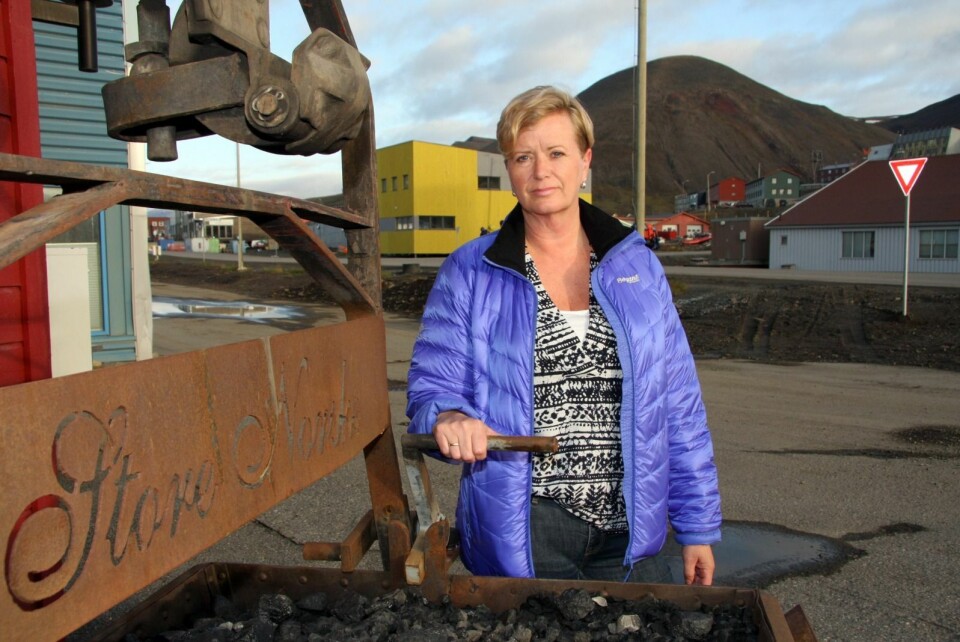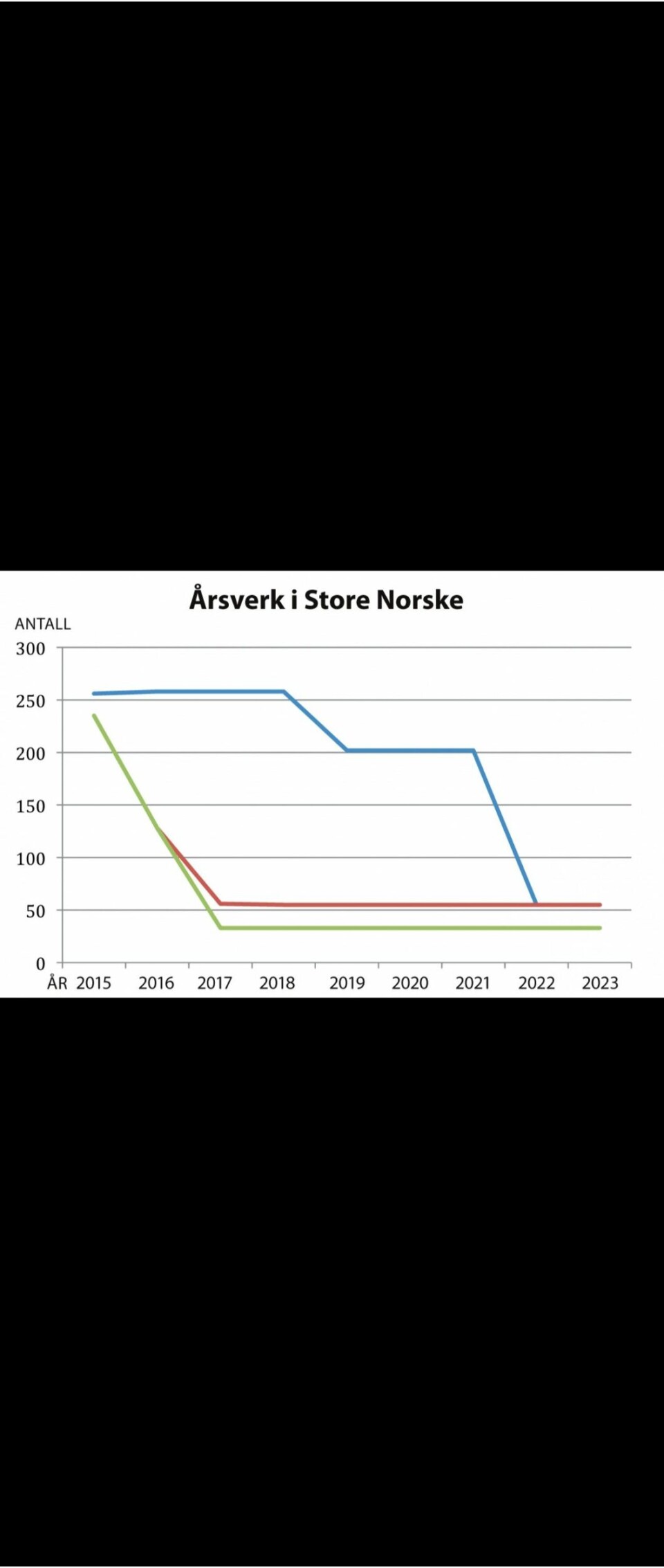Coal mining's future may be decided now
The government may have to decide whether Store Norske's coal mining at Svea and Lunckefjell will cease next year.

Denne artikkelen er mer enn 10 år gammel.

The percentage of employment with operations at Lunckefjell (blue), liquidation of Lunckefjell (red), and liquidation of both Lunckefjell and Mine 7 (green).

Employees at SNSG and related industries with operations at Lunckefjell (blue), liquidation of Lunckefjell (red), and liquidation of both Lunckefjell and Mine 7 (green).

Employees at SNSG with operations at Lunckefjell (blue), liquidation of Lunckefjell (red), and liquidation of both Lunckefjell and Mine 7 (green).
When Store Norske's board of directors meets this coming Thursday it is scheduled to consider, among other things, whether its coal mining operation at Svea will be terminated.
"Every effort had been made," Wench Ravlo, the company's administrative director, told Svalbardposten. "We have delivered, but the market is not with us."
Free fall
Since Christmas the company has terminated approximately 100 employees and turned over most of the available stones allowing it to operate cheaper. That was one of the prerequisites for getting an emergency loan the company requested. The Ministry of Trade, Industry and Fisheries purchased all of Store Norske's property and infrastructure for 295 million kroner, and provided the company with a loan of 205 million kroner.
A sky-high interest rate on the loan reflects its risk and the concerns are proving justified. Although operating costs have been reduced by about 30 percent, coal prices have plummeted in recent weeks. On Wednesday coal was selling for $53.8 a ton.
"We are dependent on a price of $65 per ton in order to break even," Ravlo said.
Selling premium industrial-quality coal from the Lunckefjell mine to new customers at higher prices than standard energy-quality coal is also part of the equation.
"The forward curve for the next six months shows $52," said Ravlo, referring to the price for standard coal, adding nothing suggests there will be a recovery.
The company will also not be rescued by the exchange rate of the dollar by the dollar due to safeguard provisions.
If the company postpones its decision until next spring, the company will need even higher prices to operation at a sustainable level.
55 employees
If coal mining stops, the result will be a hard landing for Longyearbyen (see graphic). Included in the background material for the company's board meeting board is an evaluation Store Norske prepared examining the consequences of liquidating coal mining at Svea at the end of 2016.
The forecast is a loss of 281 FTEs compared to 2015, including local related entities. Store Norwegian alone would see its workforce drop to 55 employees in 2017.
It is also uncertain whether it is possible to operate the Mine 7 profitably. A liquidation of that mine is therefore also being evaluated as an option. Longyearbyen would then lose a total of 316 employees and Store Norske would have only 33 employees by 2017.
"People are tense," Ravlo said.
What about her?
Yes I am," she said. "There is nothing that is a given now. I'm anxious about the board meeting and anxious about what happens after that. The point is that we have done what we can and must, but such is the market."
It appears the company will also report a large deficit in its second quarter report when it is completed.
On Maeland's table
One outcome of the board meeting may be the directors leaving the decision about halting mining to Trade and Industry Minister Monica Mæland. The rationale is such a large and important decision should be left to the owner – in this case, the Norwegian government which, as a condition of its assistance package, is acquiring full ownership of all Store Norske shares.
Mæland was not available by press time for an interview, but State Secretary Lars Jacob Hiim, a Conservative Party member, confirmed the ministry is concerned.
"The situation for Store Norske is serious" he wrote in an e-mail. "The government is monitoring the situation closely and the ministry is having a good dialogue with the company."
The government is now working on a new white paper detailing policy goals for Svalbard. Svalbardposten reported this summer the paper would be ready for consideration by Parliament in spring of 2016 at the earliest, but it could take even longer. The government has stated Store Norske's performance will be an important factor in drafting the paper.
'Coming suddenly'
Meanwhile, Store Norske is attempting to create new alternative jobs, including making Svea a laboratory for research, testing and developing materials for the polar regions. The tourism industry and The University Centre in Svalbard are also aiming to double in size to offset cuts to the coal company. The problem is such developments will take many years.
"We can't do it next year," Ravlo said, adding the government is facing a real headache now.
"It's coming suddenly."
Unrest
In Longyearbyen there is great concern.
"Socially speaking, it is not a good situation at all," said Arlid Olsen, the top-ranked local Labor Party candidate in this fall's municipal council election and the union steward for Store Norske's employees.
"We had the started on the path to weighing alternative industries and making a gradual transition," he said. "The consequence now, if there is to be a liquidation, is that it's going to be more demanding."
Olsen's position is supported by local Conservative Party member Torgeir Prytz.
"I am very worried about the repercussions it could have in the community," Prytz said, adding the incoming municipal council will face a demanding task facilitating new business.
"If the board comes forth with such a decision, I will be very anxious about what the owner does," said Eirik Berger, the top-ranked local Liberal Party candidate.
He emphasized the government will need to take on a financial responsibility for infrastructure in Svalbard if the company decides to halt mining.
An analysis states the local population will fall substantially if a liquidation occurs in 2016. The fewer remaining residents will therefore bear the cost.
Positive
Only the Green Party of Svalbard is welcoming the potential shutdown. Helga Bårdsdatter Kristiansen, the party's top-ranked candidate, is challenging the coal company to invest in renewable energy.
"The Green Party welcomes the liquidation of the Svea mine," she wrote in a statement. "Coal prices are historically low and coal remains an enemy of the environment."
"Store Norske must pick itself up and go on with life after coal age."
Translated by Mark Sabbatini
